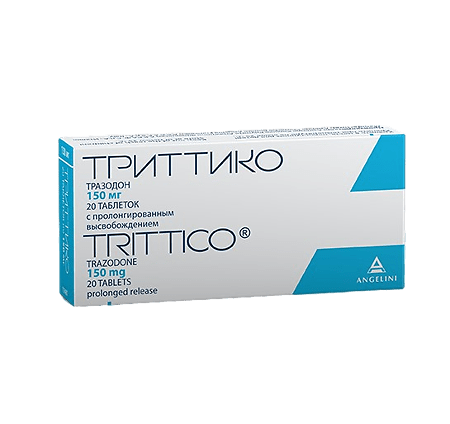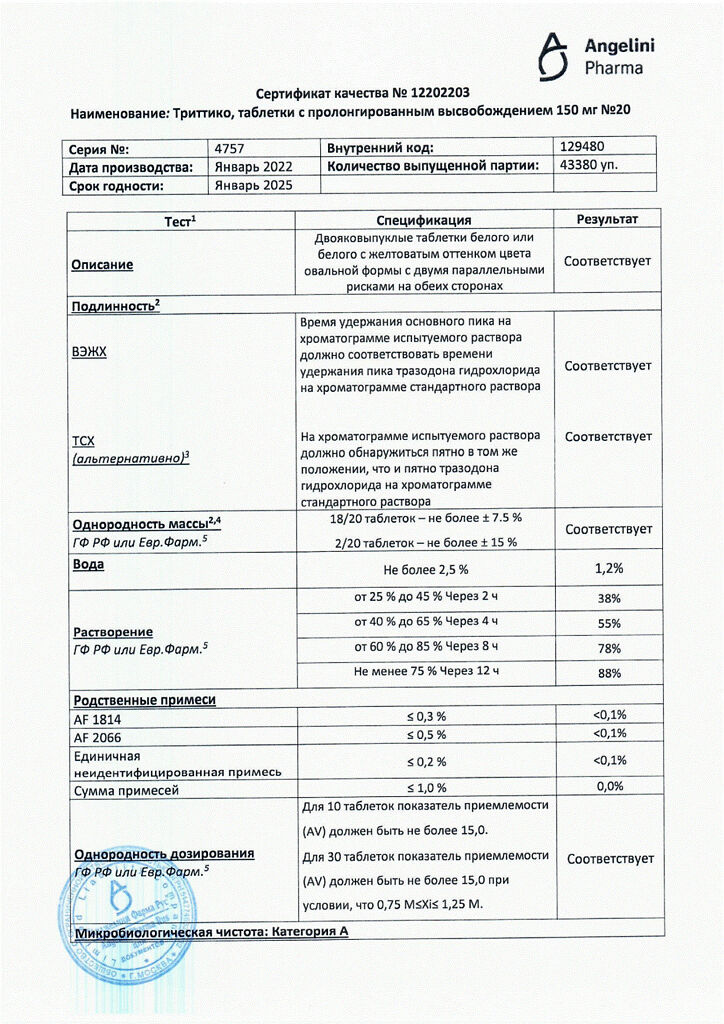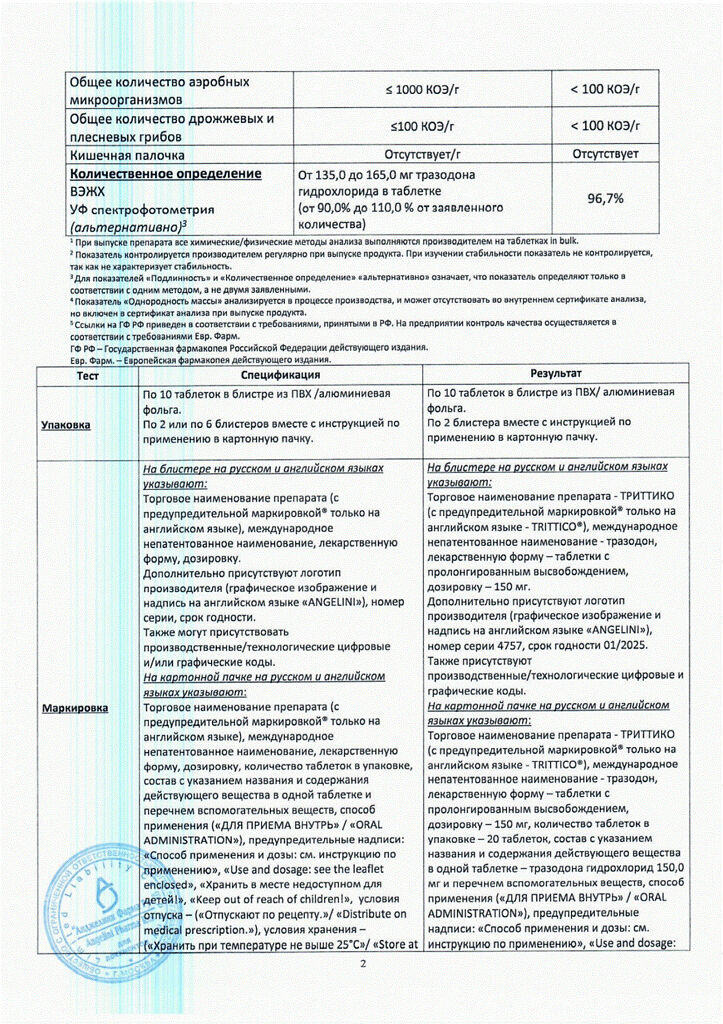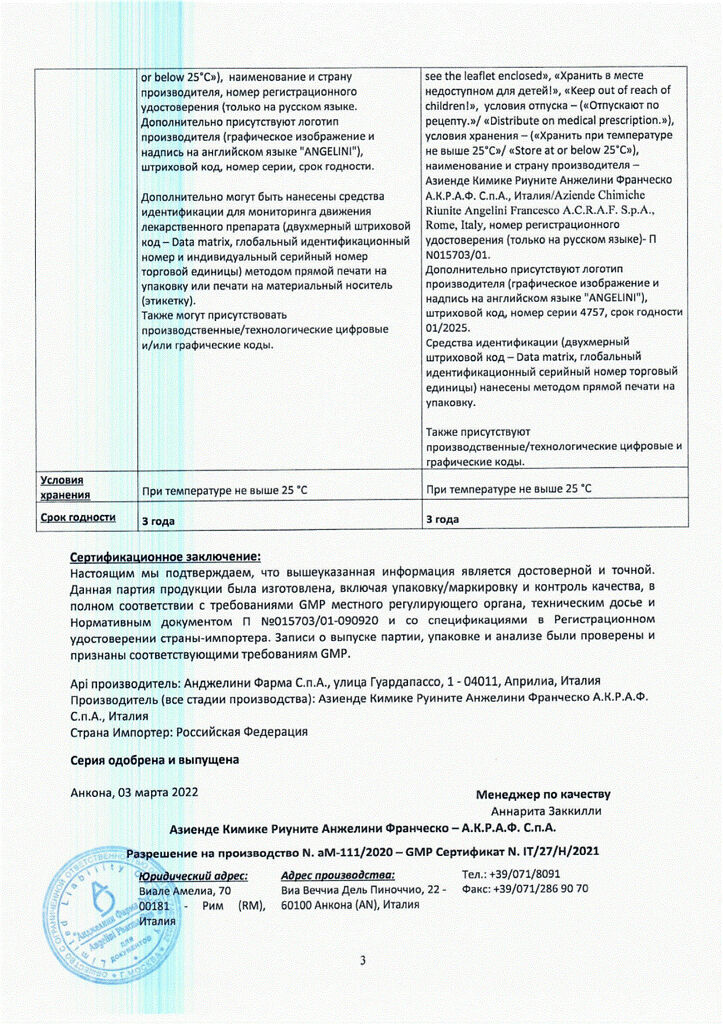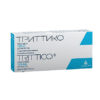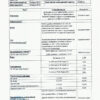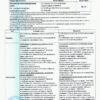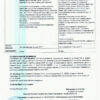No products in the cart.
Trittico, 150 mg 20 pcs.
€31.03 €25.86
Out of stock
(E-mail when Stock is available)
Description
Pharmacotherapeutic group: antidepressant
ATX code: N06AX05
Pharmacological properties
Pharmacodynamics
Trazodone is a triazolopyridine derivative effective for the treatment of depressive disorders, including depression associated with anxiety and sleep disorders, and characterized by a short latency period (about a week).
Trazodone is a serotonin reuptake inhibitor and 5-HT2 receptor antagonist whose activation is mainly associated with insomnia, anxiety, psychomotor agitation and changes in sexual function.
Unlike other psychotropic medications, trazodone is not contraindicated in glaucoma, urinary tract disorders, has no extrapyramidal effects, does not potentiate adrenergic transmission; due to the absence of anticholinergic activity, trazodone does not have the typical effects of tricyclic antidepressants on cardiac activity.
Pharmacokinetics
After an oral single dose of 75 mg of sustained-release trazodone, Cmax of about 0.7 µg/mL is reached after tmax equal to 4 hours after administration, the AUC (area under the concentration-time curve) is about 8 µg/mL/h. After oral administration of a single dose of 150 mg trazodone with prolonged release Cmax about 1.2 µg/mL is reached after tmax equal to 4 hours after administration, the AUC is about 18 µg/mL/h. The elimination half-life is about 12 hours.
A food interaction study showed no significant changes in Cmax and AUC when using the drug Trittico, 150 mg sustained release tablets, before or after meals.
Studies in vitro on human liver microsomes have shown that trazodone is primarily metabolized by cytochrome P4503A4 (CYP3A4).
Indications
Indications
Depressive disorder with or without anxiety.
Pharmacological effect
Pharmacological effect
Pharmacotherapeutic group: antidepressant
ATX code: N06AX05
Pharmacological properties
Pharmacodynamics
Trazodone is a triazolopyridine derivative effective for the treatment of depressive disorders, including depression associated with anxiety and sleep disorders, and is characterized by a short latency period (about a week).
Trazodone is a serotonin reuptake inhibitor and 5-HT2 receptor antagonist, the activation of which is mainly associated with insomnia, anxiety, psychomotor agitation and changes in sexual function.
Unlike other psychotropic drugs, trazodone is not contraindicated in glaucoma, urinary tract diseases, does not have extrapyramidal effects, and does not potentiate adrenergic transmission; Due to the lack of anticholinergic activity, trazodone does not have the typical effects of tricyclic antidepressants on cardiac function.
Pharmacokinetics
After oral administration of a single dose of 75 mg extended-release trazodone, a Cmax of about 0.7 mcg/ml is achieved after a tmax of 4 hours after dosing, and an AUC (area under the concentration-time curve) is about 8 mcg/ml/h. After oral administration of a single dose of 150 mg trazodone extended release, Cmax of about 1.2 mcg/ml is achieved after a tmax of 4 hours after administration, AUC is about 18 mcg/ml/h. The half-life is approximately 12 hours.
A food interaction study did not reveal significant changes in Cmax and AUC when Trittico 150 mg extended-release tablets were administered before or after meals.
In vitro studies on human liver microsomes have shown that trazodone is primarily metabolized by cytochrome P4503A4 (CYP3A4).
Special instructions
Special instructions
Use in children and adolescents (up to 18 years of age)
Trazodone should not be used in children and adolescents under 18 years of age.
Suicide/suicidal ideation or worsening clinical symptoms
People with depression have an increased risk of suicidal thoughts, self-harm, or suicide. This risk persists until significant remission occurs. Since improvement may not occur for the first few weeks of treatment or more, patients should be closely monitored until improvement occurs. It is common clinical experience that the risk of suicide may increase in the early stages of recovery.
It is known that patients with a history of suicidal events, or patients who exhibit a significant degree of suicidal ideation even before treatment, have a higher risk of suicidal ideation or suicide attempts, and should be closely monitored during treatment. A meta-analysis of placebo-controlled clinical trials of antidepressants used in adults with mental disorders showed an increased risk of suicidal behavior in patients under 25 years of age with antidepressants compared with placebo.
Careful monitoring of patients, especially those at high risk, should accompany drug therapy, especially in its early stages and after dose changes. Patients (and their caregivers) should be warned to monitor for any clinical deterioration, suicidal behavior or thoughts, or unusual changes in behavior, and to immediately seek professional advice if such symptoms occur. To minimize the potential risk of suicide attempts, especially at the beginning of treatment, the minimum required dose should be prescribed in each specific case.
If jaundice develops, trazodone therapy should be discontinued.
The use of antidepressants in patients with schizophrenia or other mental disorders may result in possible worsening of psychiatric symptoms. Paranoid thoughts may get worse. When treated with trazodone, depressive episodes can range from manic depression to manic psychosis. In this case, trazodone should be discontinued.
Interactions with the development of serotonin syndrome or neuroleptic malignant syndrome have been described when trazodone is used concomitantly with drugs that have serotonergic activity, such as other antidepressants (e.g., tricyclic antidepressants, selective serotonin reuptake inhibitors, selective serotonin-norepinephrine reuptake inhibitors, and MAO inhibitors) and antipsychotics. Fatal neuroleptic malignant syndrome has been reported in cases of concomitant use with antipsychotics for which this syndrome was a known possible adverse drug reaction.
Since agranulocytosis can manifest itself as a flu-like syndrome, sore throat and fever, it is recommended to monitor the blood count when these symptoms appear.
Cases of hypotension, including orthostatic hypotension and syncope, have been reported in patients receiving trazodone. Concomitant use with antihypertensive drugs may require a reduction in the dose of the antihypertensive drug.
Elderly patients
Elderly patients are often more responsive to antidepressants, and orthostatic hypotension, somnolence, and other anticholinergic effects of trazodone are more commonly reported.
Particular attention should be paid to potential additive effects due to concomitant use of other psychotropic or antihypertensive drugs or in the presence of risk factors, such as concomitant diseases, that may exacerbate these reactions.
It is recommended that the patient or caregiver be informed of the possible occurrence of such effects. It is necessary to carefully monitor their manifestation in the patient after initiation of therapy, before and after titration in an increasing dose.
During long-term therapy with trazodone, a gradual dose reduction is recommended before discontinuation of the drug to minimize withdrawal symptoms such as nausea, headache, and malaise.
There is no evidence that trazodone hydrochloride has any addictive properties.
As with other antidepressants, QT prolongation has been reported very rarely with trazodone. Caution should be exercised when administering trazodone with drugs that prolong the QT interval.
Trazodone should be used with caution in patients with known cardiovascular disease, including QT prolongation. Strong CYP3A4 inhibitors may result in increased serum levels of trazodone.
As with other drugs with alpha-adrenolytic activity, trazodone is very rarely associated with priapism. This can be corrected by intracavernosal injection of an alpha-adrenergic agent such as epinephrine or metaraminol. However, there are reports of trazodone-induced priapism that required surgery or resulted in permanent sexual dysfunction. Patients who develop this suspected adverse reaction should stop taking trazodone immediately.
Impact on urine test results
When immunoassays are used to monitor drugs in urine, the reactivity of the trazodone metabolite meta-chlorophenylpiperazine (m-CPP), which is structurally similar to methylenedioxymethamphetamine (MDMA, ecstasy), may cause a false-positive reaction to amphetamine. In these cases, confirmatory analysis using mass spectrometry is recommended.
Impact on the ability to drive vehicles and machinery
Trazodone has little or no effect on the ability to drive vehicles or use machinery. The patient should be warned of the risks when driving or operating machinery until he is sure that he is not experiencing drowsiness, lethargy, dizziness, confusion, or blurred vision.
Active ingredient
Active ingredient
Trazodone
Composition
Composition
One extended-release tablet contains:
active ingredient: trazodone hydrochloride 150.0 mg;
excipients: sucrose (pressed sugar), carnauba wax, povidone K25 (polyvinylpyrrolidone), magnesium stearate.
Pregnancy
Pregnancy
Pregnancy
Data from a limited number of pregnant women who took the drug during pregnancy (<200) did not reveal any adverse effects of trazodone on pregnancy or fetal/newborn health. There are no other epidemiological data available.
Animal studies have not revealed direct or indirect adverse effects on pregnancy, embryonic/fetal development, delivery or postnatal development at therapeutic doses.
Teratogenicity studies in rats revealed increased embryo-lethality when the drug was used only in doses toxic to the mother’s body (300-450 mg/kg/day). Embryo-lethal effects and rare cases of congenital anomalies were observed in rabbits when the drug was used only in doses toxic to the mother (150-450 mg/kg/day). The absence of a direct effect on the embryo is confirmed by studies of the penetration of trazodone through the placental barrier in rats: only minor concentrations of trazodone were found in embryonic tissues and amniotic fluid.
The drug should be prescribed to pregnant women only if the potential benefit to the woman justifies the possible risks to the fetus. When used before delivery, newborns should be monitored for signs of withdrawal syndrome.
Breastfeeding period
Limited data indicate that small amounts of trazodone are excreted in breast milk, but the level of the active metabolite is unknown. Due to insufficient data, the decision to continue/discontinue taking the drug or continue/discontinue breastfeeding should be made taking into account the benefits of breastfeeding for the child and the benefits of therapy for the mother.
Contraindications
Contraindications
known hypersensitivity to trazodone or any excipient;
alcohol intoxication and intoxication with sleeping pills;
acute myocardial infarction;
sucrose/isomaltose deficiency, fructose intolerance, glucose-galactose malabsorption, since the drug contains sucrose;
under 18 years of age (safety not established).
With caution
Caution in dosing and regular monitoring is recommended in patients with the following conditions:
epilepsy, especially a sharp increase or decrease in dose;
patients with liver and/or kidney failure, especially severe;
patients with heart diseases such as angina pectoris, conduction disorders or atrioventricular (AV) block of varying degrees, myocardial infarction (early recovery period);
hyperthyroidism;
urinary disorders such as prostatic hypertrophy, despite the slight anticholinergic effect of trazodone;
acute angle-closure glaucoma, increased intraocular pressure, although due to the slight anticholinergic effect of trazodone, no significant changes are expected.
Side Effects
Side Effects
Cases of suicidal ideation and suicidal behavior have been reported during trazodone therapy or in the early period after completion of therapy.
The following symptoms, some of which have also been reported in cases of untreated depression, have been reported in patients taking trazodone.
Organ System Class (MedDRA) Frequency unknown (frequency cannot be determined from available data)
Blood and lymphatic system disorders Agranulocytosis, thrombocytopenia, eosinophilia, leukopenia, anemia
Immune system disorders Allergic reactions
Endocrine system disorders Syndrome of inappropriate antidiuretic hormone secretion (SIADH)
Metabolic and nutritional disorders Hyponatremia1, weight loss, anorexia, increased appetite
Mental disorders Suicidal thoughts or behavior2, confusion, insomnia, disorientation, mania, anxiety, nervousness, agitation (very rarely worsening to episodes of delirium), delirium, aggressive reaction, hallucinations, nightmares, decreased libido, withdrawal syndrome
Nervous system disorders Serotonin syndrome, seizures, neuroleptic malignant syndrome, dizziness, vertigo, headache, somnolence3, restlessness, decreased alertness, tremor, visual impairment, memory impairment, myoclonic seizures, severe aphasia, paresthesia, dystonia, taste changes
Cardiac disorders Cardiac arrhythmia4 (including polymorphic ventricular tachycardia), palpitations, premature ventricular contractions, two consecutive sets of premature ventricular contractions, ventricular tachycardia, bradycardia, tachycardia, QT prolongation
Vascular disorders Orthostatic hypotension, arterial hypertension, syncope
Disorders of the respiratory system, chest and mediastinal organs Nasal congestion, shortness of breath
Gastrointestinal disorders Nausea, vomiting, dry mouth, constipation, diarrhea, dyspepsia, abdominal pain, gastroenteritis, increased salivation, paralytic ileus
Disorders of the liver and biliary tract
Liver dysfunction (including jaundice and liver cell damage)5, intrahepatic cholestasis
Skin and subcutaneous tissue disorders Skin rash, itching, hyperhidrosis
Musculoskeletal and connective tissue disorders Limb pain, back pain, myalgia, arthralgia
Renal and urinary tract disorders Urinary disorders
Disorders of the genital organs and breast Priapism6
General and administration site disorders Weakness, swelling, flu-like symptoms, fatigue, chest pain, fever
Laboratory and instrumental data Elevated levels of liver enzymes
Interaction
Interaction
General
The sedative effect of antipsychotics, hypnotics, sedatives, anxiolytics and antihistamines may be enhanced; in such cases, a dose reduction is recommended.
The metabolism of antidepressants is accelerated due to the hepatic effects of oral contraceptives, phenytoin, carbamazepine and barbiturates. The metabolism of antidepressants is inhibited by cimetidine and some other antipsychotic drugs.
CYP3A4 inhibitors
In vitro drug metabolism studies indicate that there is a potential for drug interaction when trazodone is administered with cytochrome P4503A4 (CYP3A4) inhibitors such as erythromycin, ketoconazole, itraconazole, ritonavir, indinavir, and nefazodone. If trazodone is used with a strong CYP3A4 inhibitor, a lower dose of trazodone is necessary.
The use of CYP3A4 inhibitors should be avoided whenever possible.
Carbamazepine
The results of combined use are expressed in a decrease in the concentration of trazodone in plasma. Simultaneous administration of carbamazepine in a daily dose
400 mg resulted in a decrease in plasma concentrations of trazodone and its active metabolite m-chlorophenylpiperazine to 76% and 60%, respectively. For this reason, patients taking trazodone in combination with carbamazepine should be closely monitored for the need to increase their trazodone dosage.
Tricyclic antidepressants
Concomitant use with trazodone should be avoided due to the risk of interaction. Be wary of serotonin syndrome and cardiac side effects.
Fluoxetine
Rare cases of elevated trazodone plasma levels and adverse effects have been reported when trazodone was combined with fluoxetine, a CYP1A2/2D6 inhibitor. The mechanism of their pharmacokinetic interaction has not been studied. A pharmacodynamic interaction (serotonin syndrome) cannot be excluded.
MAO inhibitors
Possible interactions with monoamine oxidase inhibitors (MAOIs) have been reported. Although some doctors prescribe the two drugs at the same time, using trazodone concomitantly with MAO inhibitors or within two weeks of stopping MAO inhibitors is not recommended. The use of MAO inhibitors within one week of trazodone therapy is also not recommended.
Phenothiazines
Cases of serious orthostatic hypotension have been reported when used concomitantly with phenothiazines, for example, chlorpromazine, fluphenazine, perphenazine.
Anesthetics/muscle relaxants
Trazodone hydrochloride may enhance the effects of muscle relaxants and volatile anesthetics and should be used with caution.
Alcohol
Trazodone enhances the sedative effect of alcohol. Alcohol should be avoided during trazodone therapy.
Levodopa
Antidepressants may speed up the metabolism of levodopa.
Other
Concomitant use of trazodone with drugs that prolong the QT interval may increase the risk of ventricular arrhythmias, including torsades de pointes. Caution is required when used in combination with trazodone.
Because trazodone is a weak norepinephrine reuptake inhibitor and does not alter the blood pressure response to tyramine, it is unlikely that compounds like guanethidine would interfere with the hypotensive effects. However, animal studies suggest that trazodone may inhibit most of the acute effects of clonidine. With other antihypertensive drugs, the possibility of potentiation should be considered, although interaction has not been clinically proven.
Side effects may occur more frequently when trazodone is used concomitantly with medications containing St. John’s wort (Hypericum perforatum).
Cases of changes in prothrombin time have been reported in patients taking trazodone and warfarin concomitantly.
Concomitant use of digoxin or phenytoin with trazodone may result in increased serum levels of digoxin and phenytoin. Serum digoxin and phenytoin levels should be monitored in such patients.
Overdose
Overdose
Symptoms: drowsiness, dizziness, nausea, vomiting. In more severe cases, coma, tachycardia, hypotension, hyponatremia, seizures and respiratory arrest have been reported. In relation to cardiac activity, these may be bradycardia, prolongation of the QT interval and polymorphic ventricular tachycardia.
Symptoms may appear within 24 hours or later after an overdose. Overdose of trazodone in combination with other antidepressants can cause serotonin syndrome.
Treatment: There is no specific antidote for trazodone. Activated charcoal may be used in adults who have taken more than 1 g of trazodone or in children who have taken more than 150 mg of trazodone within 1 hour of the onset of symptoms. As an alternative therapy, adults may undergo gastric lavage within 1 hour of taking a potentially life-threatening dose.
Observation is necessary for at least 12 hours after taking the drug, as well as monitoring blood pressure, pulse and Glasgow Coma Scale scores. If Glasgow Coma Scale scores are reduced, blood oxygen saturation is monitored. Monitoring of cardiac function is necessary in symptomatic patients.
Single short seizures do not require therapy. Frequent or prolonged seizures are corrected with intravenous diazepam (0.1-0.3 mg/kg body weight) or lorazepam (4 mg for adults or 0.05 mg/kg body weight for children).
If these measures do not control seizures, intravenous phenytoin may be recommended. To correct the acid-base balance and metabolic disorders, it is necessary to use oxygen by inhalation.
In case of hypotension and excessive sedation, symptomatic and supportive therapy should be provided. If severe hypotension persists, dopamine or dobutamine should be considered.
Storage conditions
Storage conditions
At a temperature not higher than 25 ºС. Keep out of the reach of children!
Shelf life
Shelf life
3 years.
Do not use after expiration date.
Manufacturer
Manufacturer
Aziende Chimique Riunite Angelini Francesco A.C.R.A., Italy
Additional information
| Shelf life | 3 years. Do not use after the expiration date. |
|---|---|
| Conditions of storage | At a temperature not exceeding 25 ºC. Keep out of reach of children! |
| Manufacturer | Asiende Chimica Riunita Angelini Francesco A.C.R.A., Italy |
| Medication form | sustained release tablets |
| Brand | Asiende Chimica Riunita Angelini Francesco A.C.R.A. |
Related products
Buy Trittico, 150 mg 20 pcs. with delivery to USA, UK, Europe and over 120 other countries.

